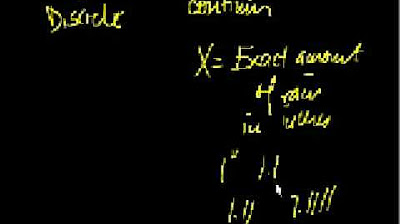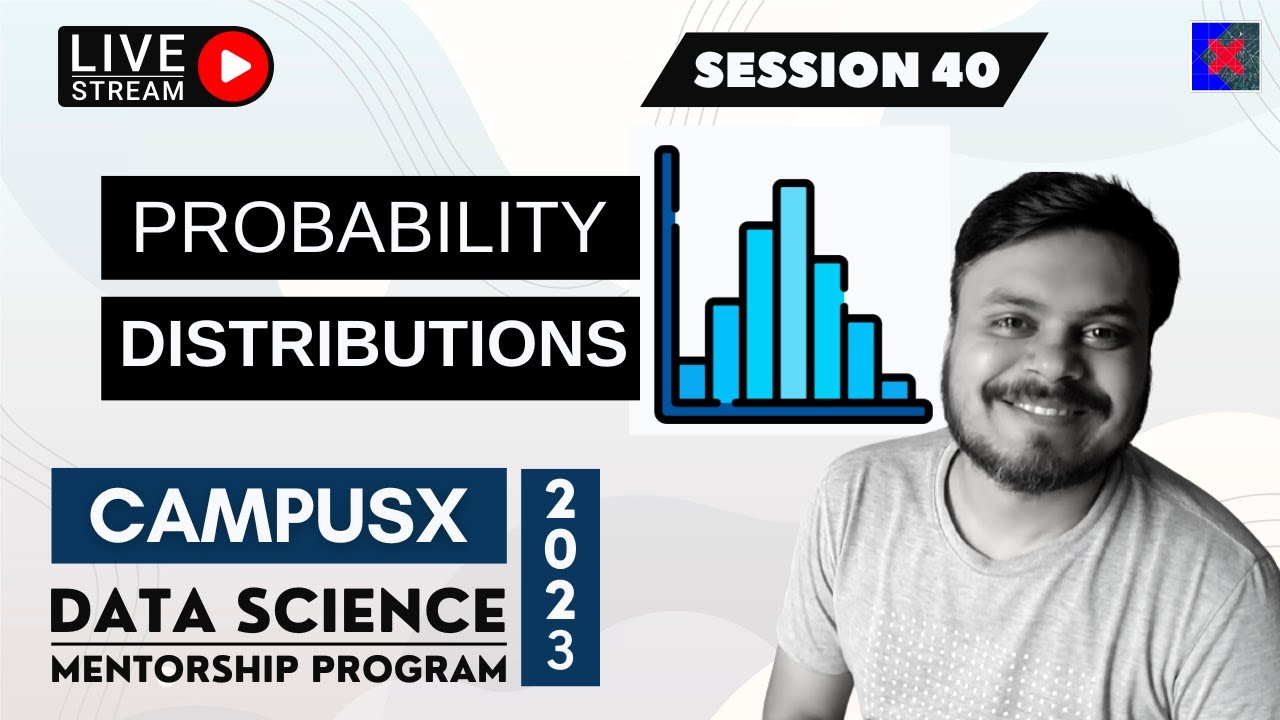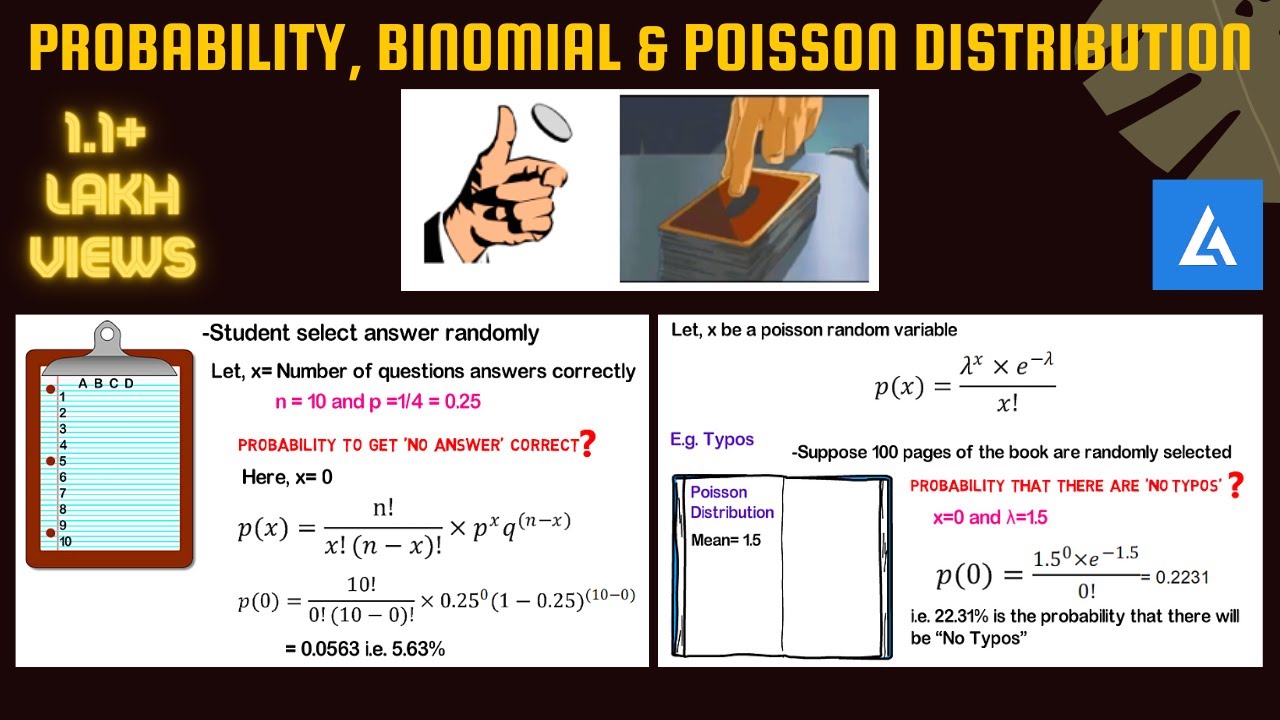Probability: Types of Distributions
TLDRThis lecture introduces various probability distributions, distinguishing between discrete and continuous types. It covers discrete distributions like Uniform, Bernoulli, Binomial, and Poisson, each suited for different scenarios such as coin flips or event frequency testing. For continuous distributions, it discusses the Normal Distribution, Student’s-T for small samples, Chi-Squared for hypothesis testing, Exponential for rapidly changing events, and Logistic for predicting outcomes based on thresholds. The summary aims to engage users with the fundamental concepts and applications of these distributions.
Takeaways
- 📚 The lecture covers various types of probability distributions, explaining their characteristics and applications.
- 🎲 Discrete distributions are used for events with a finite number of outcomes, like rolling dice or drawing cards.
- 📈 Continuous distributions apply to events with infinitely many outcomes, such as measuring time or distance in sports.
- 📝 The notation for defining distributions involves the variable name, a tilde, the distribution type, and dataset characteristics in parentheses.
- 🃏 The discrete Uniform Distribution is used when all outcomes are equally likely, such as in drawing cards or flipping coins.
- 🔄 The Bernoulli Distribution is for events with two outcomes, regardless of the likelihood of each outcome.
- 🏆 An example of a Bernoulli event is electing a captain with two possible outcomes: domestic or international.
- 🎲 The Binomial Distribution is used when conducting a Bernoulli event multiple times, like flipping a coin several times.
- 📊 The Poisson Distribution helps determine the likelihood of a certain event frequency within a given time interval, like scoring points in a game.
- 📉 The Normal Distribution is common in nature, with outcomes resembling a bell curve, such as the weight of adult male polar bears.
- 📊 The Student’s-T distribution is a small sample approximation of the Normal distribution, accommodating extreme values better with fatter tails.
- 📊 The Chi-Squared distribution is asymmetric and used in hypothesis testing for goodness of fit, not typically mirroring real-life events.
- 📈 The Exponential distribution is used for rapidly changing events, such as the initial popularity of online news articles.
- 📈 The Logistic distribution is useful in forecast analysis to determine a cut-off point for a successful outcome, like predicting victory in a game.
Q & A
What are the two main types of probability distributions mentioned in the lecture?
-The two main types of probability distributions mentioned are discrete distributions and continuous distributions.
What is the defining feature of discrete distributions?
-Discrete distributions are characterized by having a finite number of outcomes.
What example is given to illustrate a discrete Uniform Distribution?
-An example of a discrete Uniform Distribution is rolling a die or picking a card, where all outcomes are equally likely.
How is a Bernoulli Distribution defined and what example is provided?
-A Bernoulli Distribution is defined by events with only two possible outcomes – true or false. An example given is the election of a captain for a college sports team with outcomes assigned as domestic or international.
What is a Binomial Distribution and how does it relate to Bernoulli Distribution?
-A Binomial Distribution is used when a similar experiment with two possible outcomes is carried out several times. It is an extension of the Bernoulli Distribution, with multiple iterations.
When is the Poisson Distribution used and what example is provided?
-The Poisson Distribution is used to test how unusual an event frequency is for a given interval. An example is determining the likelihood of LeBron James scoring 12 points in the first quarter of a game.
What characterizes continuous distributions and how are they represented graphically?
-Continuous distributions deal with outcomes that are infinitely many and are represented graphically as curves instead of unconnected individual bars.
What is a Normal Distribution and what example is provided to illustrate it?
-A Normal Distribution is common in nature, with outcomes resembling a bell curve. An example given is the weight distribution of adult male polar bears, typically around 500 kilograms.
How does the Student’s-T distribution differ from the Normal Distribution?
-The Student’s-T distribution is used as a small sample approximation of the Normal distribution and has fatter tails, indicating more extreme values.
What is the Chi-Squared distribution used for and how is it graphically characterized?
-The Chi-Squared distribution is often used in Hypothesis Testing to determine goodness of fit. It is asymmetric and starts from 0, typically skewed to the left.
In what context is the Exponential distribution useful, and what example is provided?
-The Exponential distribution is useful for events that change rapidly early on. An example given is the number of hits an online news article generates, which declines over time.
What is the Logistic distribution used for and what example illustrates its application?
-The Logistic distribution is used in forecast analysis to determine a cut-off point for a successful outcome. An example is predicting the likelihood of victory in a competitive e-sport like Dota 2 based on early in-game advantage.
Outlines
📊 Introduction to Probability Distributions
This paragraph introduces the concept of probability distributions, distinguishing between discrete and continuous types. It explains that discrete distributions, like those for rolling dice or drawing cards, have a finite number of outcomes, while continuous distributions, such as those for measuring time and distance, have an infinite number of outcomes. The paragraph also covers the notation used for defining distributions, which includes the variable name, a 'tilde' sign, the type of distribution, and characteristics like mean and variance in parentheses. The lecture promises an overview of common discrete distributions and a separate discussion for each, starting with the uniform distribution for equiprobable outcomes, the Bernoulli distribution for binary outcomes, the binomial distribution for multiple iterations of binary outcomes, and the Poisson distribution for testing event frequency in intervals.
📈 Exploring Continuous Distributions
The second paragraph delves into continuous distributions, starting with the Normal Distribution, which is often seen in natural phenomena and characterized by a symmetrical bell curve with outliers at the extreme ends. It mentions the Student’s-T distribution as a small sample approximation of the Normal distribution, which is more accommodating to extreme values, as indicated by its 'fatter tails'. The Chi-Squared distribution is introduced as an asymmetric distribution used in hypothesis testing for goodness of fit, with a curve that is typically skewed to the left. The Exponential distribution is associated with rapidly changing events, exemplified by the decreasing interest in online news articles over time. Lastly, the Logistic distribution is highlighted for its use in forecasting and determining cut-off points for successful outcomes, using a competitive e-sport scenario as an example to illustrate its application.
Mindmap
Keywords
💡Probability Distributions
💡Discrete Distributions
💡Continuous Distributions
💡Equiprobable
💡Bernoulli Distribution
💡Binomial Distribution
💡Poisson Distribution
💡Normal Distribution
💡Student’s-T Distribution
💡Chi-Squared Distribution
💡Exponential Distribution
💡Logistic Distribution
Highlights
Introduction to various types of probability distributions and their applications in describing events.
Classification of distributions into discrete and continuous based on the number of possible outcomes.
Explanation of discrete distributions for events with finite outcomes, like rolling dice or drawing cards.
Introduction to continuous distributions for events with infinite outcomes, such as time and distance measurements.
Importance of proper notation in defining probability distributions, including the use of variable names and characteristics.
Overview of discrete Uniform Distribution for events with equally likely outcomes, like drawing cards or flipping coins.
Bernoulli Distribution for binary outcomes, regardless of the likelihood of each event.
Transformation of any two-outcome event into a Bernoulli event for simplicity.
Example of electing a captain from a group of students to illustrate the Bernoulli distribution.
Binomial Distribution for multiple iterations of binary outcomes, such as flipping a coin multiple times.
Poisson Distribution for testing the frequency of events in a given time interval, like scoring in a basketball game.
Continuous outcomes in probability distributions are represented by curves rather than discrete bars.
Normal Distribution as a representation of many natural events, with a focus on adult male polar bear weights.
Student’s-T Distribution as a small sample approximation of the Normal distribution, accommodating extreme values better.
Chi-Squared Distribution as an asymmetric continuous distribution used in hypothesis testing for goodness of fit.
Exponential Distribution for events that rapidly change early on, such as online news article hits.
Logistic Distribution for forecast analysis to determine a cut-off point for a successful outcome, like predicting victory in e-sports.
Transcripts
Browse More Related Video

Introduction to Probability Distributions

Introduction to Random Variables

Session 40 - Probability Distribution Functions - PDF, PMF & CDF | DSMP 2023

Python for Data Analysis: Probability Distributions

Types Of Distribution In Statistics | Probability Distribution Explained | Statistics | Simplilearn

Basics of Probability, Binomial and Poisson Distribution
5.0 / 5 (0 votes)
Thanks for rating: